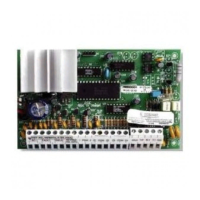Getting Started: 2.6 Supervision
5
How to Assign Keypads
Do the following at each keypad installed on the system:
1. Enter [*][8][installer’s code] to go to installer programming
2. Enter [000] for Keypad Programming
3. Enter [0] for Slot Assignment
4. Enter a two digit number (11-18) to specify which supervi-
sory slot the keypad will occupy.
5. Press [#] twice to exit installer programming.
After assigning all keypads, perform a supervisory reset by
entering section [902] in installer’s programming. The panel
will now supervise all assigned keypads and enrolled modules
on the system.
How to Program Function Keys
By default, the 5 function keys on each LCD5500Z keypad are
programmed as Stay Arm (03), Away Arm (04), Chime (06),
Sensor Reset (14) and Quick Exit (16). By default, the first
three function keys on each PC5508Z, PC5516Z, and
PC5532Z keypad are programmed as Away Arm (04), Stay
Arm (03), and Sensor Reset (14). The last two function keys
are programmed as null keys (00). You can change the func-
tion of each key on every keypad:
1. Go to the keypad where you want to change the function
key programming and enter Installer Programming.
2. Press [000] for Keypad Programming.
3. Enter [1] to [5] to select a function key to program.
4. Enter the 2 digit number, [00] to [17] to select the feature
you want the function key to have. For a complete list of
Function Key options see section 3.5 “Function Keys”.
5. Continue from step 3 until all function keys are pro-
grammed.
6. To exit Installer Programming, press [#] twice.
2.6 Supervision
By default, all modules are supervised upon installation.
Supervision is enabled at all times so that the panel can indi-
cate a trouble if a module is removed from the system.
To check which modules are currently connected and super-
vised, at an LCD keypad enter programming section [903]
from installer’s programming. The keypad will allow you to
scroll through the display of connected modules. A connected
module which does not show as being present will appear as
a trouble condition and the Trouble light on the keypad will
turn ON. This condition may be due to one or more of the fol-
lowing reasons:
• the module is not connected to the Keybus
• there is a Keybus wiring problem
• the module is more than 1,000'/305m from the panel
• the module does not have enough power
For more information regarding module supervision troubles,
please refer to “[*][2] Trouble Display”.
2.7 Removing Modules
The panel must be instructed to no longer supervise a module
being removed from the system. To remove the module, dis-
connect it from the Keybus and reset the supervision field by
entering [902] in the installer’s programming. The panel will be
reset to recognize and supervise all existing modules on the
system.
2.8 Zone Wiring
For a complete description of the operation of all zone types,
please refer to section 5.2 “Zone Programming”.
There are several different ways in which zones may be wired,
depending on which programming options have been
selected. The panel can be programmed to supervise nor-
mally closed, End-of-Line, or Double End-of-Line loops.
Please refer to the following diagrams to study each type of
individually supervised zone wiring.
NOTE: Any zone programmed for Fire or 24-hr Supervisory
must be wired with a single End of Line (EOL) resistor regard-
less of the type of zone wiring supervision selected for the
panel (section [013]: [1] -[2]). See section 5.2 “Zone Program-
ming”.
NOTE: If you change the zone supervision options from DEOL
to EOL or from NC to DEOL (section [013], options [1] or [2]),
you should power down the system completely, and then
power it back up. If you do not, the zones may not work cor-
rectly.
Normally Closed (NC) Loops
To enable normally closed loops, programming section [013],
option [1] must be ON.
NOTE: This option should only be selected if Normally Closed
(NC) detection devices or contacts are being used.
Single End Of Line (EOL) Resistors (5600Ω)
To enable panel detection of single end of line resistors, pro-
gramming section [013], options [1] and [2] must be OFF.
NOTE: This option should be selected if either Normally
Closed (NC) or Normally Open (NO) detection devices or con-
tacts are being used.
Double End of Line (DEOL) Resistors
Double End of Line resistors allow the panel to determine if the
zone is in alarm, tampered or faulted.
To enable panel detection of double end of line resistors, pro-
gramming section [013], option [1] must be OFF and option [2]
must be ON.
With DEOL selected, if the system is disarmed, the keypad
buzzers will activate when a fault or tamper occurs. Manually
bypassed zones will not show alarm, fault, or tamper conditions.
ANY Z
TERMINAL
ANY COM
TERMINAL
ANY Z
TERMINAL
ANY COM
TERMINAL

